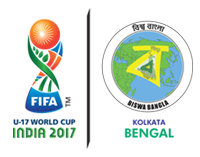A VIBRANT SPORTS CULTURE
Bengal's sports culture is vibrant, despite of absence of world-class performance by participants. It's the love for sports and games among the people that creates this vibrancy. That love may remain unrewarded with trophies, yet ardent passion for sports continues unabated.
Kolkata (Calcutta) can easily draw in more than 100,000 spectators to even a domestic soccer encounter whereas even international football elsewhere will find it difficult to duplicate that kind of passion for a match. The enthusiasm bubbles despite of the fact that Kolkata's home, India, does not figure among the first 150 soccer playing countries.
Soccer has also been the heartthrob of the city from even before independence. But Bengal had established a sports culture confined not just to football. It extends to various other sports activities as well.
One reason for this is that long before independence, British soldiers, sailors and traders introduced different forms of sports in all parts of Kolkata. Even before the birth of FIFA, organized football was well under way in various parts of Bengal, initially the headquarters of the East India Company.
A number of British regiments were posted at Kolkata and seeing them play football, local institutions encouraged youngsters to take up the game .It may come as a surprise to football fans that long before FIFA was born in 1904, Kolkata League and IFA Shield games were being played in Kolkata.
The Kolkata Soccer League began in 1898 and the IFA Shield started in 1893 .
It was about the same time that football associations were formed in south America - the Argentina Football Association in 1893 and the Uruguayan Football Confederation in 1900.
The Brazil Football Confederation was formed in June 1914, three years after Mohun Bagan won the historic IFA Shield final, defeating East Yourker, a British regimental team
This was hailed as a great victory by Indians over the British and stirred nationalist feelings throughout the country .So great was the fervour, that many openly expressed feelings that the example of Mohun Bagan flag fluttering atop the football mast should inspire the people to raise the Indian flag over Fort William, the British Military headquarters then
Mohun Bagan Club's triumph forced the then British-controlled IFA Governing Body to change their rules, with Mohun Bagan and another Indian team, Aryans, being allowed to take part in the Kolkata League as representatives of Indian clubs.
Soccer scribes are often confused between the All India Football Federation and the Indian Football Association. The All India Football Federation is the national body; it came into existence in 1937. The Indian Football association was established in Kolkata in 1892.
Before the formation of AIFF, an Indian football team was sent to Java no fewer than four times between 1924 and 1927 .The first official tour in abroad by IFA, in 1933, was skippered by the legendary Gosto Paul statue has been installed in the heart of Kolkata Maidan.
Popularity of football in Bengal has grown by leaps and bounds but cricket is fast becoming a close,if not bigger, draw.
Players of these clubs became demi-god to their millions of supporters .Mohammedan Sporting Club, though its popularity was mainly confined to Muslim supporters, reached out to Hindu players, with many of them becoming keen on donning its jerseys .
The partition of Bengal led to making people of West Bengal becoming supporters of Mohun Bagan and people who migrated from Bangladesh into ardent backers of East Bengal.
Next to football and cricket, is swimming. This is no surprise as Bengal is a state with so many rivers, ponds and lakes that attract even young children to try out swimming.
In the first two Olympics after partition, the highest number of Indian participants were from Bengal, competing in swimming, water polo and cycling events. A girl athlete from Bengal, Nilima Ghosh (later known as Nilima Vicks) represented India in the Helsinki Olympics in 1952.
It can be said sports is part of Bengali culture. Nowhere else in India do sports contests draw as big a crowd of people with knowledge of sports as in the State.
Sports may be losing some of its allure because of other attractions and strains of making a living in this super-competitive age.
But an enthusiastic sports fraternity is still very much around. With encouragement of its youth, careful section of players and rigorous training, Bengal can certainly hope to climb heights of international glory.

